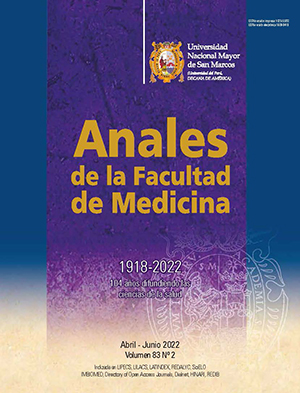Cost patterns of care for patients with ischemic heart disease at the Instituto Nacional Cardiovascular, 2019
DOI:
https://doi.org/10.15381/anales.v83i2.23187Keywords:
Myocardial Ischemia, Costs and Cost Analysis, Health Economics, PeruAbstract
Introduction. Ischemic heart disease (IHD) is currently a public health problem in Peru, and its treatment tends to be very expensive for the health system. Goal. Establish the patterns of care costs of the EIC in the National Cardiovascular Institute (INCOR) of the Social Security in Health of Peru (EsSalud). Methods. The databases of care, surgeries, discharges and gross value of INCOR production of the population diagnosed and treated with IHD in 2019 (879 patients) were used. Costs of care were estimated using activity-based costing; an econometric model was used to establish the determinants of costs, and with the Euclidean distance method, “clusters” with similar characteristics were formed to establish cost patterns. Results. The highest cost of EIC care was 148 567 soles (US$ 44 830) for a patient with a 40-day stay. The main determinants of the cost of care were the hospital stay and the number of admissions to the establishment. It was identified that the “clusters” that had a higher cost were patients with a median age of 70 and 72 years, with a high number of days of stay and with some highly complex surgery. Conclusion. Cost patterns for IHD care were associated with length of stay and readmissions to the health facility. The “clusters” with the highest cost were related to age and complexity of the surgery.
Downloads
Published
Issue
Section
License
Copyright (c) 2022 Anales de la Facultad de Medicina

This work is licensed under a Creative Commons Attribution-NonCommercial-ShareAlike 4.0 International License.
Those authors who have publications with this magazine accept the following terms:
- Authors will retain their copyrights and guarantee the journal the right of first publication of their work, which will be simultaneously subject to Creative Commons Attribution License that allows third parties to share the work as long as its author and its first publication this magazine are indicated.
- Authors may adopt other non-exclusive licensing agreements for the distribution of the version of the published work (eg, deposit it in an institutional electronic file or publish it in a monographic volume) provided that the initial publication in this magazine is indicated.
- Authors are allowed and recommended to disseminate their work over the Internet (eg: in institutional telematic archives or on their website) before and during the submission process, which It can produce interesting exchanges and increase quotes from the published work. (See El efecto del acceso abierto ).



